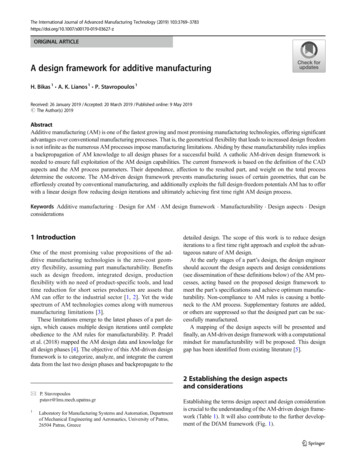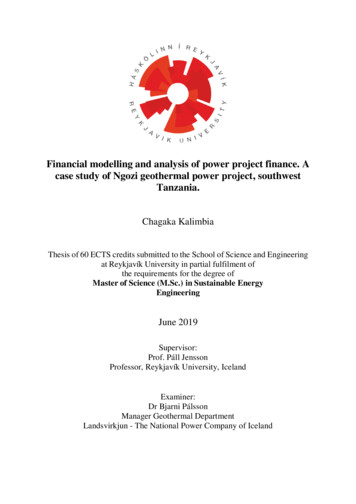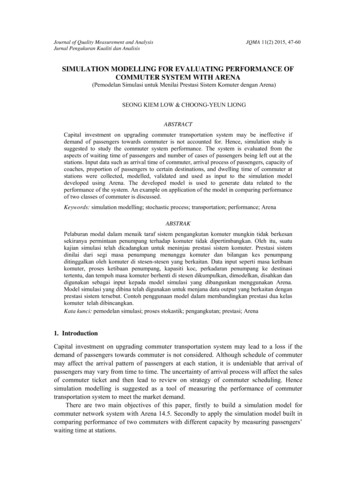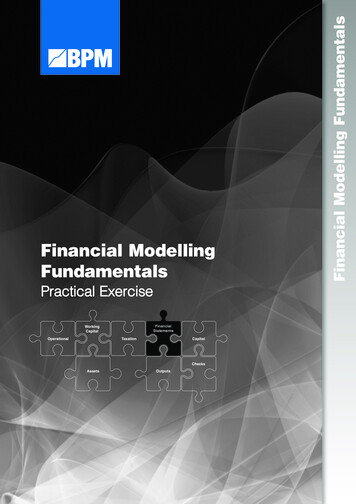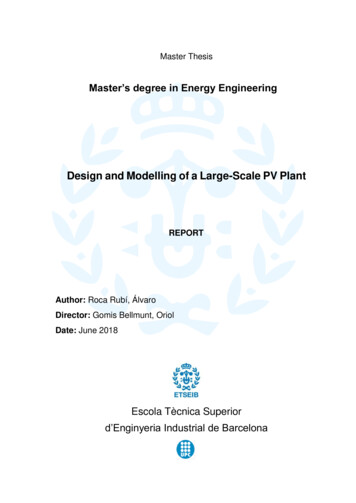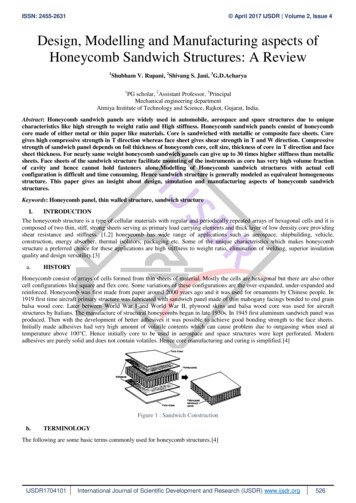
Transcription
ISSN: 2455-2631 April 2017 IJSDR Volume 2, Issue 4Design, Modelling and Manufacturing aspects ofHoneycomb Sandwich Structures: A Review1Shubham V. Rupani, 2Shivang S. Jani, 3G.D.Acharya1PG scholar, 2Assistant Professor, 3PrincipalMechanical engineering departmentAtmiya Institute of Technology and Science, Rajkot, Gujarat, India.Abstract: Honeycomb sandwich panels are widely used in automobile, aerospace and space structures due to uniquecharacteristics like high strength to weight ratio and High stiffness. Honeycomb sandwich panels consist of honeycombcore made of either metal or thin paper like materials. Core is sandwiched with metallic or composite face sheets. Coregives high compressive strength in T direction whereas face sheet gives shear strength in T and W direction. Compressivestrength of sandwich panel depends on foil thickness of honeycomb core, cell size, thickness of core in T direction and facesheet thickness. For nearly same weight honeycomb sandwich panels can give up to 30 times higher stiffness than metallicsheets. Face sheets of the sandwich structure facilitate mounting of the instruments as core has very high volume fractionof cavity and hence cannot hold fasteners alone.Modelling of Honeycomb sandwich structures with actual cellconfiguration is difficult and time consuming. Hence sandwich structure is generally modeled as equivalent homogeneousstructure. This paper gives an insight about design, simulation and manufacturing aspects of honeycomb sandwichstructures.Keywords: Honeycomb panel, thin walled structure, sandwich structureI.INTRODUCTIONThe honeycomb structure is a type of cellular materials with regular and periodically repeated arrays of hexagonal cells and it iscomposed of two thin, stiff, strong sheets serving as primary load carrying elements and thick layer of low density core providingshear resistance and stiffness. [1,2] honeycomb has wide range of applications such as aerospace, shipbuilding, vehicle,construction, energy absorber, thermal isolators, packaging etc. Some of the unique characteristics which makes honeycombstructure a preferred choice for these applications are high stiffness to weight ratio, elimination of welding, superior insulationquality and design versatility.[3]a.HISTORYHoneycomb consist of arrays of cells formed from thin sheets of material. Mostly the cells are hexagonal but there are also othercell configurations like square and flex core. Some variations of these configurations are the over-expanded, under-expanded andreinforced. Honeycomb was first made from paper around 2000 years ago and it was used for ornaments by Chinese people. In1919 first time aircraft primary structure was fabricated with sandwich panel made of thin mahogany facings bonded to end grainbalsa wood core. Later between World War I and World War II, plywood skins and balsa wood core was used for aircraftstructures by Italians. The manufacture of structural honeycombs began in late 1930s. In 1945 first aluminum sandwich panel wasproduced. Then with the development of better adhesives it was possible to achieve good bonding strength to the face sheets.Initially made adhesives had very high amount of volatile contents which can cause problem due to outgassing when used attemperature above 100 C. Hence initially core to be used in aerospace and space structures were kept perforated. Modernadhesives are purely solid and does not contain volatiles. Hence core manufacturing and curing is simplified.[4]Figure 1 : Sandwich Constructionb.TERMINOLOGYThe following are some basic terms commonly used for honeycomb structures.[4]IJSDR1704101International Journal of Scientific Development and Research (IJSDR) www.ijsdr.org526
ISSN: 2455-2631 April 2017 IJSDR Volume 2, Issue 4Figure 2 : Honeycomb Terminology Honeycomb density : the weight of one cubic meter of core expressed in kilograms (kg/m3) or pounds per cubic feet (pcf)Cell : a single honeycomb unitCell size: distance between two opposite sides of hexagonal cell.Ribbon : the flat sheet material constituting the honeycombNode: the bonded portion of adjacent ribbon sheets.Free wall: cell wall sections of single bonded sheets.Foil thickness : thickness of free wallL direction : the core ribbon directionW direction : the core expansion directionT direction: the core direction parallel with cell openings.Honeycomb Before Expansion (HOBE): the solid block of bonded sheets.c.Characteristics of honeycomb sandwichThere are some applications were light weight is a design criteria and usage of thin sheets causes buckling problem due toconcentrated loads. In such applications honeycomb panels should be used. If the loads acting are very high then thick skins arerequired. In table 1 some of the standard structural panel constructions are compared for relative strength and stiffness.Table 1 : Comparison of structural panelsStructural 100%100%26%68%62%99%64%86%3%17%Honeycomb sandwichFoam sandwichStructural extrusionSheet and stringerPlywoodHoneycomb works as energy absorbing material as it crushes uniformly at known load and has highest crush strength to weightratio of all energy absorbing materials. Aluminum honeycomb is widely used in common energy absorption applications.Stainless steel honeycomb is used for high temperature application such as nuclear power plants.[5]For mechanical structures which undergo repeated loads, fatigue properties of the core has to be investigated. Cell dimensionscore density have significant influence on the fatigue strength.[6-9]II.TYPES OF HONEYCOMBThe most common honeycomb are aluminum, Nomex, fiberglass and Kraft paper. However honeycomb can be manufacturedfrom almost any thin sheet materials. The nonmetallic cores are resin dipped in phenolics, polyamide (for high temperatures),IJSDR1704101International Journal of Scientific Development and Research (IJSDR) www.ijsdr.org527
ISSN: 2455-2631 April 2017 IJSDR Volume 2, Issue 4epoxy and thermoplastics (for toughness) resins.The corrugated aluminum honeycomb core manufacturing process is more timeconsuming than expansion method; hence the corrugated core is usually more expensive. Aluminum honeycomb is made ofcorrugation process because above 192 kg/m3 (12pcf) it becomes very difficult to expand the HOBE. If strength and modulusrequirement is very high in L direction, then reinforced cell configuration is used. Reinforcements can increase strength up to 35MPa. If corrugated slice is roll formed in W direction then sometimes nodes are separated. In such cases staggering can be doneas shown in R2S configuration in figure 3. Instead of each ribbon node contacting the entire opposite node, they are offset.[4]NormalHexagon(R1)Reinforced everyother ribbon(R2)Reinforced everyribbon(2R2)Double reinforcedevery ribbon(R2S)Reinforced everyribbon staggeredFigure 3 : Corrugated cell configurationsHexagonReinforced hexagonSquare cellsUnder expandedOver expandedFlex coreFigure 4 : Honeycomb cell configurationsa.CELL CONFIGURATIONSThe most common cell shapes are hexagon, square and flex core. Some variations of these configurations are overexpanded,underexpanded and reinforced. The hexagonal cell shape is most common for adhesively bonded honeycomb and mostlyresistance welded and brazed cores have square cells.The over expanded core allows to form cylinder in L direction. Hex cores does not easily form to curved shapes and must be rollformed or heat formed. Flex core is used when honeycomb must be formed with compound curves as this configuration can bewrapped around spherical shape as small as baseball.[4]If honeycomb cells are irregular in shape with uniform wall thickness then modulus increases considerably while Poisson’s ratiosare insignificantly affected. But for regular honeycomb, the increase in the cell wall thickness non-uniformity substantiallyreduces the elastic modulus but has very little influence on the effective Poisson’s ratio.[10]III.HONEYCOMB PROPERTIESMechanical properties to be taken into consideration for honeycomb are bare and stabilized compressive strength, stabilizedcompressive modulus, L and W plate shear strength and modulus. For energy absorption application crush strength is consideredwhich is 50 % of the bare compressive strength. In general practice, metallic honeycomb properties are specified for 15.9 mmthickness and nonmetallic honeycomb properties at 12.7 mm thickness. The compressive properties and shear modulus do notchange with thickness but shear strength decreases with increase in thickness.[4] Typical mechanical properties for Table 2 : Typical properties of Aluminum alloy honeycomb coreCore5052 Al5056 ulus(psi)(ksi)55106015L shearStrengthModulus(psi)(ksi)45125515W shearStrengthModulus(psi)(ksi)307357International Journal of Scientific Development and Research (IJSDR) www.ijsdr.org528
ISSN: 2455-26312024 Al3003 Al April 2017 IJSDR Volume 2, Issue 42.81.332070401620055421412040197Honeycomb core is orthotropic in nature. For hexagonal honeycomb, the L direction has twice the shear strength and moduluscompared to W direction. When the core is over expanded the L and W shear strength are similar and the W shear modulus isabout twice the L shear strength.Poisson’s ratio of honeycomb core cannot be determined in similar way to metals. If honeycomb core is compressed in Tdirection then cell walls can buckle inward or outward and this normal motion of one cell wall does not affect other wall. Also ifcore is compressed in L or W direction then it just deforms geometry. Hence honeycomb does not have single Poisson’s ratio.One way to determine Poisson’s ratio is to bend the core to a given radius in one direction and measure the anticlastic radius inother direction. The Poisson’s ratio is equal to –R1/R2.[4]Figure 5 : Anticlastic curvature of coreUsually honeycomb core modulus are very small compared to face sheets and hence Poisson’s ratio of core does not matter foranalysis of sandwich panel. L and W direction modulus properties are almost zero compared to T direction. Typical values ofPoisson’s ratio for commercially available core ranges from 0.1 to 0.6.IV.FAILURE OF COREWhen honeycomb panel is loaded in out of plane direction then compression and shearing occur simultaneously. As the specimenis compressed buckling of honeycomb cell walls starts from both the end face sheets. Shearing occurs due to rotation of cell wallsin combined loading conditions. Several researchers have observed effect of quasi-static and dynamic loading on honeycombpanels. There is no significant effect of loading velocity on rotational angle of core. Hence force displacement curve for static anddynamic loading conditions are nearly same. Plateau stresses are observed to increase with loading velocity.[11] The indentationresistance of honeycomb panel depends on nose geometry of indenter, cell dimensions and skin core adhesion.[12] Theexperimental results indicated that the normal crush strength under combined compressive and shear loads are lower than thatunder pure compressive loads. Hence honeycomb core is always orientated to be in pure compression along T direction.[13]V.SIMULATIONFor sophisticated analysis of structure considering sandwich panel to be subjected to combination of forces, techniques such asFinite Element Analysis can be used. In general shear forces normal to panel are carried out by honeycomb core and bending aswell as in plane forces on panel are carried by facing skins. If very detailed and accurate results are required then solid geometryof honeycomb cells can be generated. But in general engineering analysis, individual cell modelling is avoided and core issimulated as solid equivalent plate.The elastic properties of the homogeneous medium by which the sandwich core is replaced in the analysis can be determined byeither experimental, analytical or numerical methods. Young’s modulus in thickness direction can be determined by compressiontests.[14] Shear characterization of the sandwich cores was carried out based on sandwich beam subjected to three pointbending.[15,16] out of plane shear modulus can be determined by simple dynamic technique with four accelerometers.[17] Ahomogenization method is introduced by wang et al for linear elastic problems to analyze complicated distribution of the stressesand strains around core.[18]When defining properties of honeycomb core following points should be taken into consideration. Modulus in L and W directionsare nearly zero. But very small values may need to be applied to avoid singularity.EL EW 0 ,μLW μTW μLT 0The study of the mechanical behavior of a composite material commonly uses the homogenization concept. The equivalentcharacteristics of a honeycomb sandwich plate are determined by identifying its membrane and bending stiffness to those of anisotropic plate as shown in figure .[19]IJSDR1704101International Journal of Scientific Development and Research (IJSDR) www.ijsdr.org529
ISSN: 2455-2631 April 2017 IJSDR Volume 2, Issue 4Figure 6 : Equivalent parameters of Honeycomb sandwich plateTable 3 : Equivalent parameters of sandwich structureHoneycomb sandwich plate2Et1 v2Eth22(1 v 2 )Membrane stiffnessBending stiffnessEquivalent isotropic plateEeq t eq1 v2Eeq t 3eq12(1 v 2 )Where teq (3h2)1/22 tEeq 3 h EIn anisotropic mechanical behavior, all honeycomb are closed cell structures. By identifying a unit cell and deriving the volumefraction occupied by metal, the equivalent density is given by [20]2ϱt t 2ϱc (H t)Ρeq VI.t eqMANUFACTURING OF COREThere are five basic ways of manufacturing honeycomb : adhesive bonding, resistance welding, brazing, diffusion bonding andthermal fusion.[4][21-24] Among these methods, most common manufacturing method is adhesive bonding. Resistance welding,brazing and diffusion bonding are only used for cores to be used at very high temperatures. There are two basic methods ofmanufacturing honeycomb core by adhesive bonding.1.2.Expansion methodCorrugation methodA schematic of expansion process for honeycomb core manufacturing is shown in figure 7. Metallic sheet is cut into specifieddimensions and strips of adhesive are printed on it. Adhesive is applied in such a way that adhesive prints on adjacent sheets areshifted by half of the distance between adjacent prints on the same sheet. After solidification and curing of the adhesive, HOBEblock is sliced into required thickness of the core and then HOBE slice is expanded to form honeycombs.Figure 7 : Expansion method of core manufacturingIJSDR1704101International Journal of Scientific Development and Research (IJSDR) www.ijsdr.org530
ISSN: 2455-2631 April 2017 IJSDR Volume 2, Issue 4Figure 8 : Corrugation method of core manufacturingManufacturing of core by corrugation method is shown in figure 8. In this method corrugations are produced by pressing metallicsheet between toothed rollers. Corrugated sheets are then bonded, brazed or resistance welded to form honeycomb core. Thismethod is generally preferred for high density cores which cannot be expanded due to thick and strong metallic sheets.[4]VII.SANDWICH PANEL FABRICATIONThe basic components of sandwich panel are core, facings and adhesive. Face sheets can be metallic or composite prepreg.Prepreg such as fiberglass, Kevlar and CFRP can be precured and bonded to honeycomb core with adhesive. Resin from thecomposite prepreg bonds fiber with core and therefore adhesive is not necessary for composite skins. The common methods ofbonding panels are with the help of autoclaves,vacuum bagging and presses. Autoclaves and vacuum bagging are generally usedfor curved parts and presses for flat panels.Figure 10: Autoclave or Vacuum bagging processFigure 11 : Heated press methodWhen composite laminate is made in an autoclave generally either 121 C or 177 C cure cycle for 1 hour after heat up rate of 1.12.2 C per minute with pressure around 0.48 MPa is used. Similar cure cycles can be adopted for metallic facings however amountof pressure to be applied depends on compressive strength of core. Honeycomb cores cannot withstand any side pressures. Hencecare must be taken to use seals on sides to prevent it from caving inward.VIII.CONCLUSIONA summary of honeycomb sandwich panel terminologies, characteristics and properties are described. Various configurations ofhoneycomb cells and types of hexagonal honeycomb cores with reinforcements are studied and illustrated. To avoid modelling ofactual hexagonal cells in CAD software, easier approach to model equivalent homogenized structure for FEA is described.Manufacturing processes for Honeycomb core and sandwich structures are explained.REFERENCES[1]L.J. Gibson and M.F. Ashby, Cellular Solids: Structure and Properties, 2nd ed, Cambridge University Press, Cambridge,1997, p.12.[2]Y.J. Chen, X.Q. Zuo, and Q.N. Shi, Development and application of honeycombed metal, Mater. Rev.,2003, Issue.12,p.32.[3]Guo, Shiju, et al. "Fabrication and compressive performance of plain carbon steel honeycomb sandwich panels." Journalof University of Science and Technology Beijing, Mineral, Metallurgy, Material Vol15.Issue 3 (2008): 255-260.[4]Bitzer, T. N. Honeycomb technology: materials, design, manufacturing, applications and testing. Springer Science &Business Media, 2012[5]Zhang, X., Zhang, H., & Wen, Z. (2014). Experimental and numerical studies on the crush resistance of aluminumhoneycombs with various cell configurations. International Journal of Impact Engineering, Vol.66, 48–59.[6]Jen, Y. M., Ko, C. W., & Lin, H. Bin. (2009). Effect of the amount of adhesive on the bending fatigue strength ofadhesively bonded aluminum honeycomb sandwich beams. International Journal of Fatigue, Vol.31(Issue 3), 455–462.[7]Demelio G, Genovese K, Pappalettere C. An experimental investigation of static and fatigue behaviour of sandwichcomposite panels joined by fasteners. Composite Part B, 2001;Vol. 32 Issue4:299–308.IJSDR1704101International Journal of Scientific Development and Research (IJSDR) www.ijsdr.org531
ISSN: 2455-2631 April 2017 IJSDR Volume 2, Issue 4[8]Shafiq B, Quispitupa A. Fatigue characteristics of foam core sandwich composites. InternationalJornal of Fatigue2006;Vol.28(Issue2):96–102[9]Côté F, Deshpande VS, Fleck NA. Shear fatigue strength of a prismatic diamond sandwich core. i, K., Gao, X. L., &Subhash, G. Effects of cell shape and cell wall thickness variations on the elastic properties of twodimensional cellular solids. International Journal of Solids and Structures,2005,42(5–6), 1777–1795.[11]Ashab, A. S. M., Ruan, D., Lu, G., & Wong, Y. C. Quasi-static and dynamic experiments of aluminum honeycombsunder combined compression-shear loading. Materials and Design, 2016, 97, 183–194.[12]Crupi, V., Epasto, G., &Guglielmino, E. Comparison of aluminium sandwiches for lightweight ship structures:Honeycomb vs. foam. Marine Structures,2013,30, 74–96.[13]Hong, S. T., Pan, J., Tyan, T., & Prasad, P. Dynamic crush behaviors of aluminum honeycomb specimens undercompression dominant inclined loads. International Journal of Plasticity, 2008, 24(1), 89–117.[14]F. Mujika, J. Pujana, M. Olave, On the determination of out-of-plane elastic properties of honeycomb sandwich panels,Polymer TestingVol.30 (Issue 2) (2011) 222–228[15]G. Caprino, A. Langella, Study of a three-point bending specimen for shear characterisation of sandwich cores, Journalof Composite Material,2000, Vol. 34 (Issue 9), 791–814.[16]Jiang, D., Zhang, D., Fei, Q., & Wu,S. An approach on identification of equivalent properties of honeycomb core usingexperimental modal data. Finite Elements in Analysis and Design, 2014, 90, 84–92.[17]C.W. Schwingshackl, G.S. Aglietti, P.R. Cunningham, Determination of honey- comb material properties: existingtheories and an alternative dynamic approach, Journal of Aerospace Engineering,2006,Vol.19 (Issue 3), 177–183.[18]F.Wang, S. Zhuang, J. Yu, Application of homogenization FEM to the equivalent elastic constants of honeycombstructures, ActaMechnica Sinica,2002, 34 (6), 914–923.[19]Boudjemai, A., et al. "Thermo-mechanical design of honeycomb panel with fully-potted inserts used for spacecraftdesign." Recent Advances in Space Technologies (RAST), 2013 6th International Conference on. IEEE, 2013[20]A. Boudjemai, R. Amri, A. Mankour, H. Salem, M.H. Bouanane, D. Boutchicha, Modal analysis and testing ofhexagonal honeycomb plates used for satellite structural design, pp. 266–275, Materials & Design, Volume 35, March 2012.[21]H.N.G. Wadley, N.A. Fleck, and A. G. Evans, Fabrication and structural performance of periodic cellular metalsandwich structures, Composite Science and Technology, 63(2003), p.23-31.[22]R.J. Feng and J.M. Yu, Honeycomb filled board and its application in automotive industry, Automobile Technology andMaterial, 2003, No.8, p.30[23]J. Zhang, F. Feng, and Y.M. Zhu, A study on bonding process of aluminum honeycomb sandwich panel. ElectroMechanical Engineering 2,2005, Vol. 21, p.41.[24]W.S. Burton and A.K. Noor, Structural analysis of the adhesive bond in a honeycomb core sandwich panel, IJSDR1704101International Journal of Scientific Development and Research (IJSDR) www.ijsdr.org532
This paper gives an insight about design, simulation and manufacturing aspects of honeycomb sandwich structures. Keywords: Honeycomb panel, thin walled structure, sandwich structure I. INTRODUCTION The honeycomb structure is a type of cellular materials with regular and peri


